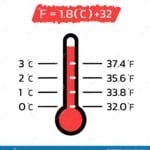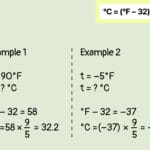Decoding 47°C: Just How Hot Is It?
You check the weather app and see a sweltering “47°C.” If you’re unfamiliar with the Celsius scale, this number might seem meaningless. But don’t worry, we’re here to demystify Celsius and convert 47°C to its more familiar Fahrenheit equivalent.
Celsius to Fahrenheit: The Conversion Formula
Scientists have developed a simple formula to convert between Celsius and Fahrenheit:
°F = (°C × 9/5) + 32
Let’s plug in 47°C:
°F = (47°C × 9/5) + 32
°F = 116.6°F
So, 47 degrees Celsius translates to a scorching 116.6 degrees Fahrenheit.
Feeling the Heat: What 116.6°F Feels Like
116.6°F is extreme heat. Imagine the hottest summer day you’ve experienced and intensify it. This level of heat isn’t just uncomfortable; it can be dangerous, potentially leading to heatstroke, especially with prolonged exposure.
Remember that humidity significantly impacts how hot it feels. High humidity makes it harder for your body to cool down through sweat evaporation, making 116.6°F feel even more oppressive.
Celsius vs. Fahrenheit: A Tale of Two Scales
Why do we have two temperature scales? Centuries ago, Anders Celsius and Daniel Gabriel Fahrenheit, both brilliant minds, developed their own systems for measuring temperature.
Celsius: The Global Standard: Celsius, favored for its simplicity, is widely used in scientific settings and most countries worldwide. Its scale sets 0°C as water’s freezing point and 100°C as its boiling point.
Fahrenheit: Familiar but Flawed: The Fahrenheit scale, while prevalent in the United States, is less intuitive. It sets water’s freezing point at 32°F and its boiling point at 212°F.
Beyond the Numbers: The Importance of Understanding Temperature
Converting 47°C to Fahrenheit is just the beginning. Understanding temperature scales is crucial for:
- Interpreting weather reports accurately.
- Following recipes from different parts of the world.
- Comprehending scientific data and research.
- Making informed decisions about your health and well-being, especially during extreme weather conditions.
Effortless Celsius to Fahrenheit Conversion
Let’s explore how to easily convert between these two temperature scales.
The Logic Behind the Formula
Fahrenheit and Celsius are like two languages for temperature, each with different “zero points” and “degrees” of change.
- Multiplying by 9/5: This adjusts for the difference in the “size” of each degree. One degree Celsius equals 1.8 degrees Fahrenheit.
- Adding 32: This accounts for the shift in the starting point of the scales (0°C = 32°F).
A Step-by-Step Example: Converting 20°C to Fahrenheit
Let’s say the weather app shows a pleasant 20°C. Here’s how to convert it to Fahrenheit:
- Multiply by 9: 20 x 9 = 180
- Divide by 5: 180 / 5 = 36
- Add 32: 36 + 32 = 68
Therefore, 20 degrees Celsius is a comfortable 68 degrees Fahrenheit.
The Quick Conversion Shortcut
For rough estimations, try this shortcut: double the Celsius temperature and add 30. This method is less accurate at higher temperatures but provides a general idea.
How Hot is 45°C in Fahrenheit?
45 degrees Celsius converts to a scorching 113 degrees Fahrenheit. To put this into perspective:
- Boiling Point of Water: 212°F (100°C)
- A Very Hot Day: 95-100°F (35-38°C)
- Room Temperature: 70-75°F (21-24°C)
- Freezing Point of Water: 32°F (0°C)
At 113°F, heat exhaustion is a serious risk. Staying hydrated and minimizing exposure is vital.
What is 50°C in Fahrenheit?
Let’s convert 50 degrees Celsius to Fahrenheit using our formula:
- Multiply by 9/5: 50 * 9/5 = 90
- Add 32: 90 + 32 = 122°F
So, 50 degrees Celsius equals a toasty 122 degrees Fahrenheit.
Key Points:
- Conversion Formula: °F = (°C × 9/5) + 32
- 47°C to Fahrenheit: 116.6°F
- Temperature Perception: 116.6°F is extremely hot and potentially dangerous.
- Humidity: High humidity intensifies the feeling of heat.
- Celsius vs. Fahrenheit:
- Celsius (scientific): Freezing point – 0°C, Boiling point – 100°C
- Fahrenheit (common in US): Freezing point – 32°F, Boiling point – 212°F
- Importance of Understanding Temperature Scales:
- Accurate interpretation of weather reports and scientific data.
- Informed decisions about health and well-being in different temperatures.
Knowing how to convert between Celsius and Fahrenheit is a valuable skill. Remember the formula, use the shortcut for estimations, and stay aware of the impact of temperature on your environment and health. For instance, you know that the freezing point of water is different in Fahrenheit and Celsius, so if you happen to have a recipe that uses temperature in Fahrenheit, and you only have a thermometer calibrated in Celsius, you can convert 99f to celcius to find the appropriate temperature to set your stove. Similarly, if you see the temperature for a hot summer day is 53 degrees Celsius, convert this to Fahrenheit using 53 centigrade fahrenheit to see if you should wear a sweater or not.
- Discover Long Black Pepper: Flavor & Health Benefits - April 25, 2025
- Shocking Twists: The Grownup Review: Unreliable Narration - April 25, 2025
- A Quiet Place Book vs Movie: A Deep Dive - April 25, 2025
















3 thoughts on “Is 47 Celsius Hot? Converting to Fahrenheit for Clarity”
Comments are closed.